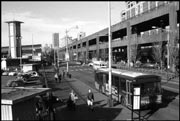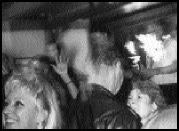The Alaskan Way Viaduct is falling down. Sure as rain in winter, the ungainly, double-decked concrete highway that girds the waterfront can’t defy gravity forever, and when it goes, it will take commuters, trucks, and several buildings down with it. Fixing the viaduct—the stated goal of those on every side of the heated debate over what to build, or not to build, in its place—is thus a race against time. A major earthquake could come at any moment. According to the state Department of Transportation, Seattle faces 1-in-20 odds of a viaduct-closing quake in the next 10 years. But time and money are hard to come by. Come April, according to Mayor Greg Nickels’ office, money for the city-state partnership that’s working on viaduct alternatives will run dry, unless the city can come up with stopgap funding to keep the initiative going. They’re lobbying hard at the state Legislature, but so far, according to City Council President Peter Steinbrueck, “I don’t hear them accepting full responsibility for this.”
And that’s just the least of the problems related to the viaduct. The big-picture questions—what can we afford, and how are we going to pay for it?—are also far from settled. Nickels’ new-and-improved, nipped-and-tucked list of alternatives ranges from somewhere in the $2 billion range all the way to—gulp—$5 billion. (For perspective, that’s more than twice the cost of Sound Transit, three times the size of the monorail project, and it’s getting pretty close to the $7 billion-plus it will cost to expand Interstate 405.)
ALL OF WHICH suggests that viaduct visionaries need to think small. And in at least one instance—the so-called boulevard or surface option, which would replace the viaduct with a surface street along the waterfront—they have. The new boulevard would likely be six lanes, but could be four. It would probably have stoplights at major intersections to allow pedestrian access to the waterfront. Like all the options, it would include a partial seawall replacement. And it would cost hundreds of millions less than the other three alternatives, which range from $2.4 billion to rebuild the viaduct in place to $4.7 billion to tuck the viaduct underground through its crucial downtown segment.
Still the least specific of the four proposals, the surface option has its naysayers—most members of the Seattle City Council among them—and proponents. But considering the resounding defeat of Referendum 51, the gas-tax proposal rejected by voters in November, and the possibility that its companion regional measure might meet a similar fate next year, smaller might not merely be better. It might be all we have.
SIX MONTHS AGO, talking about a surface option would have been just short of heresy. The consensus, some might call it dogma, was that the only sensible solution was to bury the viaduct underground from Queen Anne Hill to Safeco Field and Seahawks Stadium, at an estimated cost of nearly $12 billion. “I think everyone was caught up in the dream—which I think was a good dream—of having it underground and being able to pay for that,” says City Council Transportation Committee chair Richard Conlin. Now, they’re waking up with the worst urban-planning hangover of their lives. “I think there’s a fair chance [a surface street] could be dramatically less expensive,” Conlin says, perhaps by as much as $1 billion. But would cutting corners now condemn us to a future of nightmarish gridlock and unending traffic misery?
Naturally, there are those who say yes. Steinbrueck, for one, couldn’t be less enthusiastic about turning the viaduct into a boulevard. Characteristically, the council president doesn’t mince words, asserting that the surface option “borders on insanity.” Turning the central waterfront over to a raging six-lane highway with 110,000 cars a day—120,000, if you count the traffic that’s already on Alaskan Way—”would destroy downtown and the central waterfront. It absolutely would not work,” Steinbrueck says, “and I think it ought to be summarily abandoned as soon as possible.” James Young of the Downtown Seattle Association, which still supports tunneling despite the cost, frets that turning the viaduct into a surface street will lead to “as much as a 40 percent reduction in capacity.” Even Steinbrueck’s colleague, Nick Licata, who strongly believes the viaduct should be retrofitted, not replaced, agrees with the council president on at least this point: “It will create incredible gridlock,” Licata says. “You’re going to end up with a waterfront you can look at across six lanes of traffic but never touch.”
CALM DOWN, SAYS Conlin. Other cities have knocked down major elevated freeways—San Francisco, New York, and Portland among them—and not only did disaster fail to strike, in some cases traffic congestion actually diminished. In San Francisco, which shut down its Central Freeway in 1996 (after the waterfront Embarcadero Freeway was demolished in the early ’90s), traffic on the city’s major transportation corridors actually decreased, leaving transportation planners scratching their heads. Where did the commuters go? The San Francisco Chronicle called the disappearing commuters “San Francisco’s greatest mystery.” Later that year, a study by California’s Transportation Department found that people changed their commute times, stopped coming into town, or found alternative ways to get around.
Could the same thing happen here? Peter Hurley, director of the Transportation Choices Coalition, thinks it could. Congestion, Hurley says, forces people to find alternatives to driving alone, such as car pools, vanpools, and mass transportation. (Accordingly, the monorail is a key part of transportation planners’ traffic projections.) “If you look at other places that have done this, it’s not the end of the world,” Hurley says. “If you give people realistic choices, they’ll use them.” And if enough people choose alternatives, Hurley says, building a surface street “may not reduce capacity at all.”
In fact, some might argue, it could increase it, by spreading people more evenly through downtown surface streets. “There probably is excess capacity out there,” says Bob Chandler, the viaduct project manager for the city’s Transportation Department. “With surface options, you use more of the street grid.” According to Conlin, a recent poll revealed that given a choice between paying $1 to drive on the viaduct—a near-certainty under all but the surface option—and finding other alternatives, most people would look for other options. “And if that’s the case,” Conlin wonders, “then why should we build something we don’t even want to use?”
Conlin goes even further, suggesting that a surface alignment could actually be narrower than the current viaduct—down to four lanes instead of six. That would almost certainly push some traffic onto surface streets downtown and slow freight traveling along the viaduct, officially known as Highway 99. But downtown streets also will likely be clogged under the tunnel alternative, which would eliminate the existing access ramps at Columbia and Seneca streets. (The two aerial alternatives, which would rebuild or reconfigure the viaduct but leave it elevated through downtown, would preserve the ramps.) With a tunnel, traffic entering or leaving the viaduct would have to do so north or south of downtown, creating choke points on both ends of First Avenue. In contrast, a boulevard could link up to major downtown streets, giving pedestrians and cars easier access to downtown and spreading traffic more evenly around the central city. Brian Steinburg, a member of Action Better City, a nonprofit that promotes “livable communities,” believes reconnecting the street grid might be one solution to the city’s downtown traffic problem. “In grid cities, you have congestion at peak times, but, in general, traffic moves pretty well, because people can always find an alternative route,” Steinburg says.
OUTSIDE THE DRY vernacular of traffic management, there’s the perennial question of what we want the waterfront to be, and how much traffic we’re prepared to handle before we say enough is enough. “One thing Seattle needs to ask itself,” Steinburg suggests, “is do we need 110,000 cars moving at 55 mph through our downtown core, or do we just need to provide a way for people to get into and out of the city and also accommodate through traffic?”
A four-lane roadway also looks good to people like David Yeaworth, president of arts and urban-design promoters Allied Arts. Although Allied Arts has pushed relentlessly for a buried viaduct, Yeaworth says a boulevard might be worth a look—but only if it would allow for civic space and easy connections from downtown streets. “Psychologically, the viaduct creates this wall that keeps people from going to the waterfront,” Yeaworth says. “You don’t want to have a surface road that would just take up all of the surface space right there and not provide space for people.” What kind of space? At a minimum, the urban-design crowd Yeaworth represents would like to see a wide pedestrian promenade, a good mix of sidewalk amenities and open space, and crosswalks that allow pedestrians to get from one side of the roadway to the other. “The conversation has been stuck on, ‘What’s the best construction method, and how much does it cost?’ when the real question should be, ‘Does it make the waterfront a place people want to be?'” Steinburg says. “That’s what’s intriguing about a surface option, if it’s done right.”









